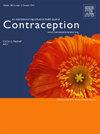Racial and ethnic differences in risk for hysterectomy following insertion of a levonorgestrel-releasing intrauterine device: A retrospective cohort study
IF 2.3
2区 医学
Q1 OBSTETRICS & GYNECOLOGY
引用次数: 0
Abstract
Objectives
Evidence regarding risk for hysterectomy following treatment for benign gynecological conditions with a levonorgestrel-releasing intrauterine device (LNG-IUD) is limited. We assess whether race and ethnicity are associated with hysterectomy risk and moderate associations between other patient characteristics and hysterectomy risk.
Study design
From health care records (US South; 2014–2019), we identified a retrospective cohort of 783 patients (aged 18–44 years; non-Hispanic White n = 455; non-Hispanic Black n = 208; Hispanic n = 120) receiving LNG-IUD treatment for a benign condition, followed to hysterectomy or study end (September 18, 2019). Indices measuring preinsertion bleeding, gynecological pain, and bulk symptom severity were abstracted from 4 months’ medical records preceding insertion. Associations between race and ethnicity, age, symptom severity, presence of fibroids and endometriosis, prior IUD use, parity, and insurance and hysterectomy risk were investigated with Kaplan-Meier estimates and Cox regression.
Results
Seventy-six patients (9.7%) underwent hysterectomy (median follow-up: 1.7 years). Hysterectomy rates were 7.0% within 1 year, climbing to 14.9% at 4 years post-insertion. Hysterectomy rates did not differ significantly by race and ethnicity. Age at treatment, symptom severity, fibroids, parity, and insurance status were associated with hysterectomy, but only age (hazard ratio per unit increase: 1.04 [95% CI: 1.00–1.09]), bleeding severity (1.05 [1.00–1.10]), and bulk severity (1.15 [1.00–1.32]) remained associated with adjustment. There was no evidence that race and ethnicity moderated these associations.
Conclusions
We did not find statistically significant differences in hysterectomy risk for Black, Hispanic, and White LNG-IUD patients. Patients who were older and had more severe pre-insertion uterine bleeding and bulk symptoms were more likely to undergo hysterectomy. These associations did not differ by race and ethnicity.
Implications
Among patients being treated with LNG-IUDs for benign gynecological conditions, Black, Hispanic, and White patients did not differ significantly in hysterectomy risk, but older patients and those with more severe bleeding and bulk symptoms were more likely to undergo hysterectomies.
植入左炔诺孕酮释放宫内节育器后子宫切除术风险的种族差异:一项回顾性队列研究。
目的:关于使用左炔诺孕酮释放宫内节育器(LNG-IUD)治疗良性妇科疾病后子宫切除术风险的证据有限。我们评估种族和民族是否与子宫切除术风险相关,以及其他患者特征与子宫切除术风险之间的中度关联。研究设计:来自医疗记录(美国南部;2014-2019年),我们确定了783例患者的回顾性队列(年龄18-44岁;非西班牙裔白人n=455;非西班牙裔黑人n=208;西班牙裔n=120)因良性疾病接受LNG-IUD治疗,随后进行子宫切除术或研究结束(2019年9月18日)。从插入前4个月的病历中提取插入前出血、妇科疼痛和整体症状严重程度等指标。采用Kaplan-Meier估计和Cox回归研究种族和民族、年龄、症状严重程度、子宫肌瘤和子宫内膜异位症的存在、宫内节育器使用史、胎次和保险以及子宫切除术风险之间的关系。结果:76例(9.7%)患者行子宫切除术(中位随访时间1.7年)。子宫切除率在一年内为7.0%,在植入后4年攀升至14.9%。子宫切除术率在种族和民族之间没有显著差异。治疗年龄、症状严重程度、肌瘤、胎次和保险状况与子宫切除术相关,但只有年龄(每单位增加的风险比:1.04[95% CI: 1.00-1.09])、出血严重程度(1.05[1.00-1.10])和体积严重程度(1.15[1.00-1.32])仍然与调整相关。没有证据表明种族和民族调节了这些关联。结论:我们没有发现黑人、西班牙裔和白人LNG-IUD患者子宫切除术风险的统计学差异。年龄较大且有更严重的插入前子宫出血和体积症状的患者更有可能接受子宫切除术。这些关联没有因种族和民族而异。意义:在使用lng - iud治疗良性妇科疾病的患者中,黑人、西班牙裔和白人患者的子宫切除术风险无显著差异,但老年患者和出血和体积症状更严重的患者更有可能接受子宫切除术。
本文章由计算机程序翻译,如有差异,请以英文原文为准。
求助全文
约1分钟内获得全文
求助全文
来源期刊

Contraception
医学-妇产科学
CiteScore
4.70
自引率
17.20%
发文量
211
审稿时长
69 days
期刊介绍:
Contraception has an open access mirror journal Contraception: X, sharing the same aims and scope, editorial team, submission system and rigorous peer review.
The journal Contraception wishes to advance reproductive health through the rapid publication of the best and most interesting new scholarship regarding contraception and related fields such as abortion. The journal welcomes manuscripts from investigators working in the laboratory, clinical and social sciences, as well as public health and health professions education.
 求助内容:
求助内容: 应助结果提醒方式:
应助结果提醒方式:


